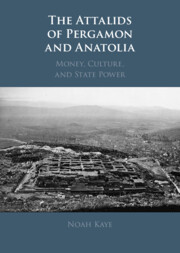Book contents
- The Attalids of Pergamon and Anatolia
- The Attalids of Pergamon and Anatolia
- Copyright page
- Dedication
- Contents
- Figures
- Graphs
- Maps
- Acknowledgments
- List of Abbreviations
- Introduction
- 1 Eating with the Tax Collectors
- 2 The Skeleton of the State
- 3 The King’s Money
- 4 Cities and Other Civic Organisms
- 5 Hastening to the Gymnasium
- 6 Pergamene Panhellenism
- Conclusion
- Appendix of Epigraphical Documents
- Bibliography
- Index Locorum
- Subject Index
Conclusion
- The Attalids of Pergamon and Anatolia
- The Attalids of Pergamon and Anatolia
- Copyright page
- Dedication
- Contents
- Figures
- Graphs
- Maps
- Acknowledgments
- List of Abbreviations
- Introduction
- 1 Eating with the Tax Collectors
- 2 The Skeleton of the State
- 3 The King’s Money
- 4 Cities and Other Civic Organisms
- 5 Hastening to the Gymnasium
- 6 Pergamene Panhellenism
- Conclusion
- Appendix of Epigraphical Documents
- Bibliography
- Index Locorum
- Subject Index
Summary
Why Pergamon? Our story began with ten Roman commissioners, who in 188 BCE drew up a new map for cis-Tauric Asia after the defeat of Antiochos III at Magnesia-under-Sipylos. That map was an artifact of the Settlement of Apameia. A century-old Mediterranean interstate system had broken down at the end of the third century, and the Romans’ map proposed just two pieces of a new geopolitical order, the partition of the Anatolian peninsula between two allies, Rhodes and Pergamon. The failure of Rhodes to integrate or even retain control over its share along the south coast in Lycia and Caria is emblematic of the fact that enforcement of the settlement fell to the actors on the ground. The Romans withdrew and did not soon return, even as Pan-Anatolian wars between Pontos, Pergamon, Bithynia, and their respective allies embroiled the entire region for a decade. While a cunning and opportunistic diplomacy had helped put the Attalids in a position to win an empire, sovereignty over these vast new territories and peoples was never guaranteed. This was the basic assumption of an inquiry into the mechanics of imperial rule, rapid state formation, and the ideological tendencies of the Pergamene kings. My central argument was that the Attalids creatively employed noncoercive means to capture control of Greek cities and Anatolian rural communities, ultimately, making local civic culture depend on their tax revenues.
- Type
- Chapter
- Information
- The Attalids of Pergamon and AnatoliaMoney, Culture, and State Power, pp. 354 - 363Publisher: Cambridge University PressPrint publication year: 2022

